| | Cadet History, 1984 THE CADETS' GOLDEN ANNIVERSARY YEAR
This is an abbreviated and very narrowly focused version of an article I wrote
on the 1984 DCI Championships in Atlanta, Georgia. The complete article was
published in Drum Corps World. These edited excerpts are reprinted with the kind
permission of Steve Vickers the Publisher of DCW. (See link to DCW on this website).
Dave Shaw | |
| |
In all probability I would not have attended the 1984 DCI Championships in
Atlanta had it not been for an earlier visit to DCI East in Allentown where my
curiosity was piqued. Allentown was a pleasant evening, relatively free of
excitement or surprises... save one. This is not to imply that the corps present
were not excellent. They were in fact quite excellent. It was Garfield, though,
that grabbed my stunned attention. I have written many articles about many corps
over the years, and very seldom have I found myself unable to articulate my
reaction to a corps' performance. This proved to be one of those times.
Once before, at a competition in a small town in Wisconsin many years ago, I
had a similar disbelieving reaction to what I was seeing. In that instance I was
viewing for the first time Santa Clara's great production incorporating
contrasting time signatures; "Young People's Guide, Bottle Dance," etc. The
entire production was so obviously superior to anything that had preceded it, it
projected drum corps into an entirely new sphere of development.
Now, once again, as Garfield performed, I felt I was viewing something so
entirely new and different, intuitively I knew drum corps would never again be
the same. I not only wanted to see them perform their "West Side Story" show
again, I had to see it again. Then, within a short period of time following
Allentown, reports began to reach me of subsequent contest results. First,
Garfield's loss to Phantom Regiment at DCI Canada, then their defeat by Santa
Clara at DCI Midwest, and finally their loss to the Blue Devils in a DCI
second-tour contest. My reaction was total disbelief. I couldn't believe that
it was possible that three other corps had simultaneously reached Garfield's
level of innovative excellence and executional prowess in a single season.
It called into question the validity of my own initial reaction in Allentown
to what I had witnessed. After all, I had been away from active participation
in drum corps for a long time. Perhaps my ability for objective evaluation had
been lost during my absence. The answer, I felt, could only be found by traveling
to the championships in Atlanta. I had to either reaffirm or reevaluate what I
had seen in Allentown.
Conversations among those with an insider's viewpoint at the Sheraton DCI
Headquarters in Atlanta seemed to indicate that the title could go to any one of
five corps: Garfield, Santa Clara, Blue Devils, Phantom Regiment, or the dark
horse, Madison Scouts. I became more and more questioning of my earlier
conclusions, conversation by conversation. I still hadn't seen Phantom Regiment,
Santa Clara, or Blue Devils; but if four other corps were on the same level as
the Garfield I had seen in Allentown, this was destined to be not only the most
hotly contested DCI Championship in history, but an unprecedented giant leap
forward by not just one, but an entire block of DCI's most competitively
successful corps. Frankly, I was more than just a little skeptical of that
scenario.Garfield's appearance as the last competing corps in semi-finals gave
me my first opportunity to confirm or reassess my earlier reaction to their
Allentown performance.
Disclaimer: Before proceeding, I'd like to inform those reading this article
that I was a marching member of the Holy Name- Garfield Cadets from 1950-58, a
member of Garfield's management staff from 1959-62, and again 1971-72. I had
not, however, been connected with the Cadets in any capacity in twelve years,
and with the exception of their financial manager, I did not personally know,
nor did I have any contact with, nor would I even recognize on sight, any member
of their management or instructional staffs, or any of the marching members of
Garfield. I considered myself to be as objective as time and distance would
permit. Others reading this report might not agree.
| |
| | 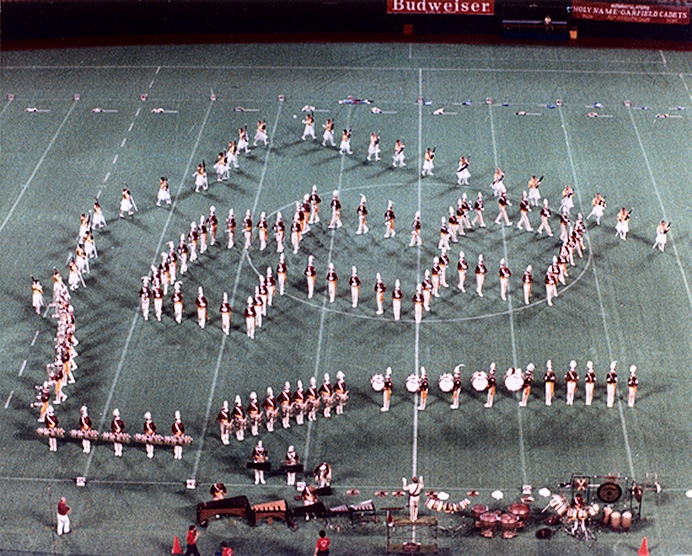
| |
| | | |
| |
All four of Garfield's major competitors in Atlanta were absolutely title-level;
with excellence written all over them; but their programs and executional
prowess were not substantively different from what was anticipated by the
experienced viewer in the stands with any degree of prior multiple-viewing
exposure and familiarity with the individual stylistic approach of each of
the four. Garfield, by contrast, presented an approach in programming design,
with a level of originality and effectiveness so elevated above the competition,
it was and still is difficult for me to provide adequate description for lack of
prior points of reference. What Garfield had was a total cohesiveness between
captions that utilized every note of music, every step, every dance movement,
every flutter of cloth, every change of cadence and time signature, every hand
movement, every facial gesture, every nuance of emotion; as one part of a
totally integrated performance concept with professionally conceived timing
and forward progression.
When you watched Garfield perform they pulled you, almost without your conscious
realization, to the edge of your seat, and totally commanded your attention.They
directed your visual focus and emotional response without even a hint of heavy
handedness or excess. They treated their entire performance package as a single
production number with stunning success. There had never been a program like it
before. It was light years removed from what was heretofore considered
the standard of excellence. And, on top of the design superiority, their
performance level bordered on flawless. Evidence the fact that three
judges in semi-finals gave them unprecedented perfect scores (visual ensemble,
percussion ensemble, and GE percussion). It did not, therefore, come as a very
great surprise to me that Garfield's semi-finals score topped the field at
97.50. Nor did I have any reason to reassess my Allentown reaction.
As finals approached it was obvious that all of the five main title-contenders
had pretty much equalized levels of performer talent and performance excellence.
They were all extremely effective in communicating their message to the
audience. They all demonstrated tthe executional proficiency and professionalism
that in 1984 set them apart from the next grouping of corps. Any choice between
them would be totally subjective on the part of the individual viewer. There
was, however, one glaringly obvious point of differentiation. None of Garfield's
title-challengers presented a program radically different from what they had
successfully marketed in prior seasons.
And so, that was the dilemma for the judges. They had to position five corps of
equal talent and proficiency and performance level; all of whom matched or
exceeded all their own previous-established standards of excellence. So what was
to be the point of differentiation? Effectiveness? That's pretty subjective and
loosely defined. That left difficulty and creativity (defined as the infusion of new
concepts) ...and that left Garfield above the pack. Was a one tenth spread realistic?
Probably not. The score sheets and the scoring system weren't really designed to
accommodate four superior corps, plus a fifth corps that redefined the entire activity.
In the final championship competition Garfield again received three perfect
scores (visual ensemble, visual general effect, and brass general effect). Note
that Garfield was the only corps to receive perfect scores in any of the
qualifying or finals competitions; an indication, as were the perfects 10s
awarded in men's gymnastic competition at the Olympics in 1984, that something
outside the realm of prior experience had occurred, and that the system of
evaluation wasn't prepared to accommodate it. | |
| | 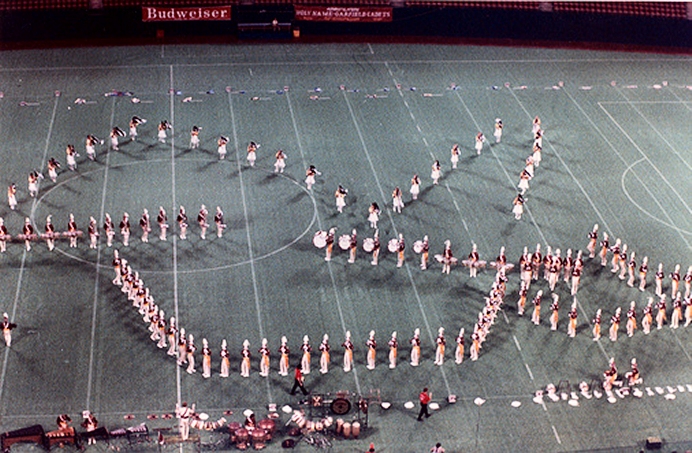
| |
| | | |
| |
Garfield now faces the possibility of becoming a victim of their own success.
Where do they go from here? If they change their programming approach this
winter there will be some that will be extremely distressed at the prospect of
never seeing the brilliance of Garfield's 1984 formula on the field again. On
the other hand many others will expect them to once again provide the lead in
innovation and creativity, that may or may not be as competitively successful.
The choice is mind-boggling. If they do take off in a new direction next season,
and the result is something even minutely less creative or less artistically
successful, they will be criticized. Even if they should succeed in
accomplishing what appears to be the impossible, and they manage to find an even
newer and more successful approach, there will be those that begrudge them that
accomplishment because they are tired of Garfield's consistent success of the
past two seasons and want to see a different champion in the headlines.
And what about drum corps' dilemma? What has Garfield's success, based on
difficult-to-duplicate innovation, wrought for the activity across-the-board? We
now have a new standard of excellence to be measured against. Garfield did not
take a single step forward in creativity...they took several giant steps
forward. Can the rest of the activity and the corps competing against Garfield
match the pace? How many creative people of the caliber of Garfield's staff are
there in the activity? How much more will that creativity cost us?
If my observation that all DCI title-contender corps reach a uniform level of
performance execution proficiency by DCI finals each year is valid, that means
that the title is, for all intents and purposes, decided on the drawing boards
at staff meetings long before the corps ever enters their first contests.
Budgets for major DCI corps across the country probably jumped thousands of dollars a
year as a result of Garfield's success. The trickle-down effect is
enormous...and what's the option? After all, the essence of this activity is to
be competitively successful. By recognizing the creative genius of what might be
a once-in-a-lifetime drum corps giant, have we just cut our own throats?
I wish I had the answer. Only the future will tell. | |
| |
To read an insider's perspective of what it was like to be a member of the 1984
Cadets, in day-by-day diary format, consider purchasing the book authored by
Cadet David Welch 84-87 called "The Middle Horn Leader 2006" (illustrated below).
It takes you on a magnificent journey of discovery into the mind of a rookie Cadet.
I recommend it to everyone interested in what drum corps is really all about. 100%
of the proceeds from the sale of this book are dedicated to Brain Cancer Awareness.
It is available through Amazon.com. | |
| | 
| |
| | | |
| |
Comments from David Welch:
1.) The scoring system in 1984 was the first year they moved from a tick-based
system to a merit-based system of judging. They were trying to figure things
out during the summer. Garfield won with a score of 94.4 in 1983. In 1984, the
winning score was 98.0. Figuring out this new scoring system was a source of
wrangle between the staff and the judges ALL summer long.
2.) The staff in 1984 was unique in the history of drum corps. Look at how many
of those people are now in the DCI Hall of Fame: George Zingali (1991), Jim
Prime, Jr. (1996), Michael Cesario (1996), George Hopkins (1997), Marc Sylvester
(2001), Thom Hannum (2001), Donnie VanDoren (2004), Peggy Twiggs (2005). Then,
1984 drum caption Tom Aungst was inducted in 2006. Eight staff members and one
marching member are now in the Hall of Fame, all from the 1984 Garfield Cadets.
Can that be said for any other single year for a drum corps? (Good question.
Probably not.)
3.) Our field percussion suffered in 1984 because Zingali was asking for them to
be in certain places on the field and to move to those places in a manner that
had never been demanded before. So, technique had to be invented throughout the
summer for them to move their bodies with that equipment. Techniques for doing
this took at least through the end of the 1985 season to invent, let alone
perfect. The marching techniques that started in 1984 were invented and
perfected across the entire corps by 1987, and now, all this marching technique
is "standard" across drum corps – with few exceptions. (For example, The
Cavaliers who have a much different approach to movement.)
4.) The real metric for a show is how it is remembered in time. The 0.1 margin
at finals is not what people remember. The General Effect aspect of the corps
is what has stood the test of time. That is one of the only things I hear when
people make comments about the 1984 West Side Story production.
5.) When we lost at Whitewater, we had just fallen flat on our faces, literally.
(Before we went on for DCI Finals, Hopkins read us a letter from Don Angelica
saying that we would have to fall on our faces like at Whitewater in order to
lose. Hopkins was crying as he read this letter to us. It was the last thing
we heard before singing "Holy Name" and going onto the field to perform.
| |
| | THIS I BELIEVE...TRUTH, VALUE, AND THE PERSONAL EXPERIENCE CALLED DRUM CORPS.
IT APPLIES NOW...IT APPLIED IN 1984...IT APPLIED IN 1934. FOR HOLY NAME SHALL ALWAYS BE... | |
| |
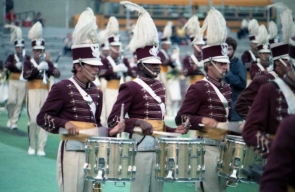 | 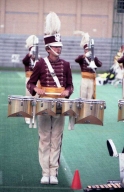 | 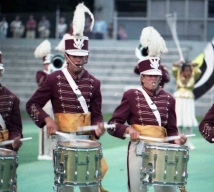 |
| 1984 Closeup of Snares and Horns | 1984 Cadet
Lee Jeffries Quads | 1984 Cadets
Tom Aungst R. & Diane Gatley L. |
|
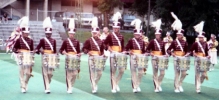 | 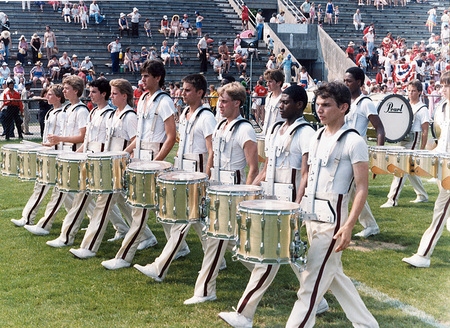 | 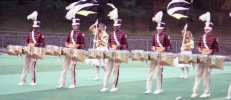 |
| 1984 Snare Line | Garfield 1984 Snares Parade Bridgeport | 1984 Tom Line |
|
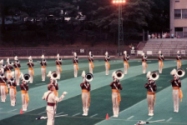 | 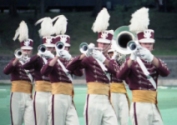 | 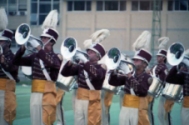 |
| Garfield 1984 Maria | 1984 Lead Sopranos | 1984 Mellos on Field |
|
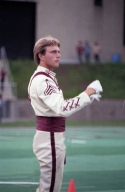 | 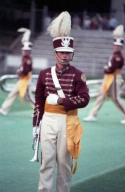 | 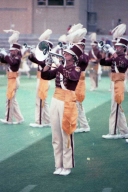 | 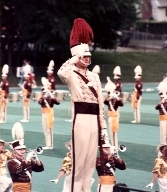 |
1984 Drum Major
Dave Leytze | 1984 Horn Player Close-up | 1984 Great Mellophone. | 1984 Drum Major
Rich Armstrong. |
|
| |
| | Photos Credit Todd Ullrich | |
|
